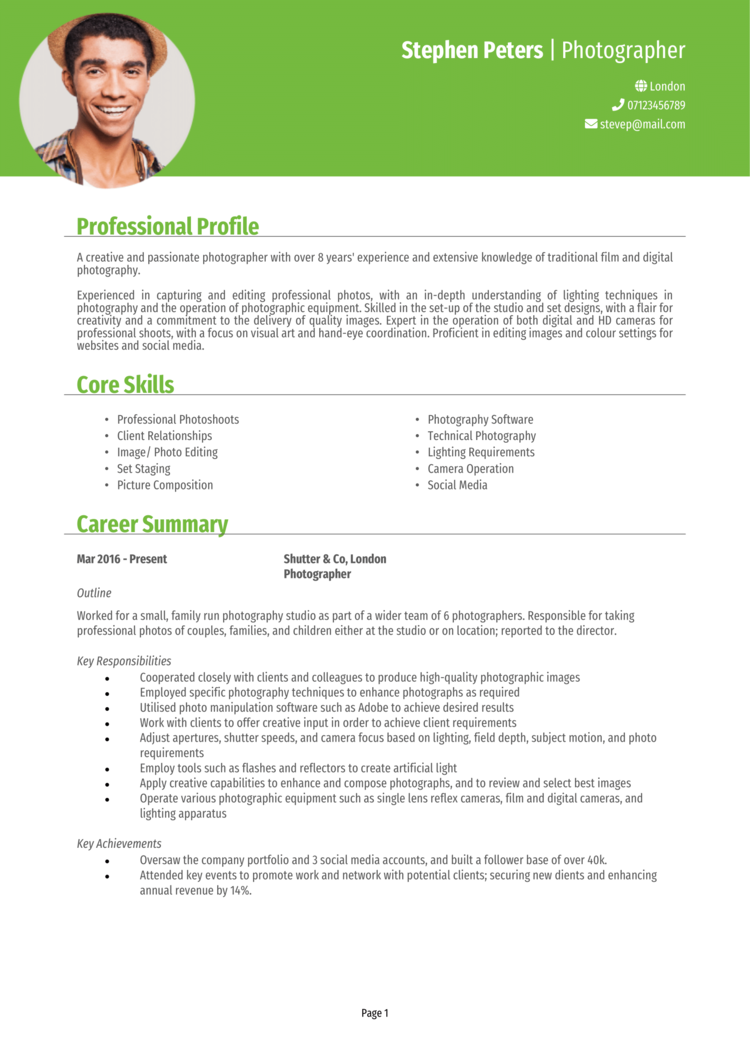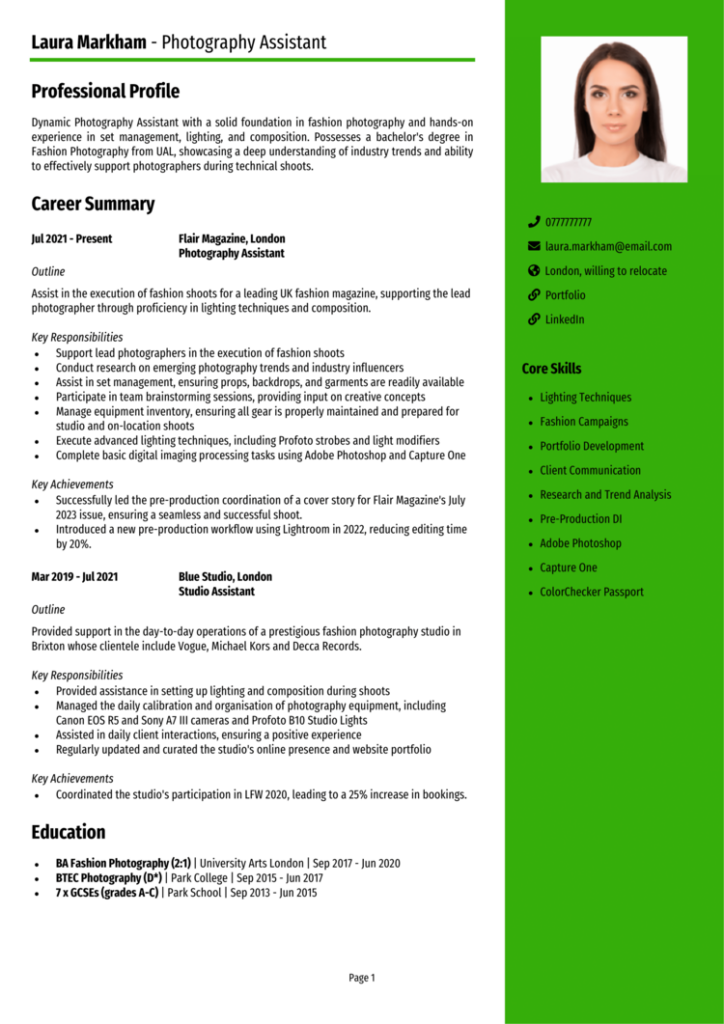You’ve mastered capturing the perfect shot, but now it’s time to frame yourself in the best possible light – with a CV that snaps up interviews faster than a DSLR in burst mode.
These Photographer CV examples and step-by-step guide will showcase your skills behind the lens, land interviews, and turn your passion into a thriving career. Let’s get started – you’re just one click away from creating a CV that gets you noticed.
Photographer CV

Fashion Photographer CV

Freelance Photographer CV

Photography Assistant CV

How to write your Photographer CV
Learn how to create your own interview-winning Photographer CV with this simple step-by-step guide.
A Photographer CV is more than just a list of jobs. It’s your chance to prove that your creativity, technical expertise, and eye for detail are exactly what employers are looking for.
In this guide, you’ll learn how to write a CV that highlights your portfolio, technical skills, and experience – helping you land roles that let your talent shine.
How to create a good structure for your Photographer CV


Think of your CV like a photo gallery: it should be well-organised, showcase your best work, and leave recruiters scrolling for more. A clear CV structure helps employers see your talents at a glance.
Here’s how to structure your Photographer CV:
- Name and contact details – Your contact details belong at the top so potential clients or employers can easily reach you. Including a picture of yourself is optional, but you’re already good at those!
- Profile – Start with a compelling summary of your style, technical skills, and experience.
- Core skills – Then, highlight your abilities, such as editing software expertise or studio lighting.
- Work experience – Share your projects and roles in reverse chronological order, focusing on your impact.
- Education – Show off any academic qualifications, photography courses, and certifications in your CV.
- Additional info – Another optional section lets you state your hobbies and interests that reflect creativity or a passion for storytelling.
Photographer CV format


A messy CV format is like an overexposed photo – no matter how much potential is there, it’s hard to see the value. Keep the layout as sharp and well-composed as the final edit for the best results. Make sure your design is clean, professional, and easy to read to ensure recruiters focus on your achievements, rather than visual mistakes.
Here’s how to format your Photographer CV effectively:
- Bullet points – A good CV should break down information for quick reading and clarity.
- Divide sections – Use headings to guide readers through your CV effortlessly.
- Use a clean font – Choose a professional font that’s as easy to read as your portfolio is to admire.
- Keep it the right length – No more than 2 pages is plenty of length to showcase your talent without losing the reader’s interest.
Photographer CV profile


Your profile is your introduction to the employer – a snapshot of why you’re the best choice for their project or team. It should quickly cover everything from your experience to your enviable expertise.
Photographer CV profile examples
Profile 1
Creative Photographer with five years of experience in portrait and wedding photography. Skilled in capturing authentic moments, editing using Adobe Lightroom and Photoshop, and providing excellent client service. Delivered photo albums that consistently exceeded client expectations.
Profile 2
Organised Commercial Photographer with four years of experience producing high-quality imagery for e-commerce and product brands. Proficient in studio lighting, product styling, and post-production editing. Known for delivering visually compelling images that drive online sales and customer engagement.
Profile 3
Experienced Event Photographer with over eight years of expertise covering corporate events, concerts, and festivals. Skilled in working in dynamic environments, using advanced camera equipment, and producing professional, high-resolution images that align with client goals.
What to include in your Photographer CV profile
Here are some tips on what to put in your Photographer CV profile:
- Where you’ve worked – Note the types of studios, publications, or freelance projects you’ve been part of.
- Your top qualifications – Talk about any formal training, such as photography degrees or certifications.
- Your style and expertise – Quickly mention your niche, like portraiture, landscapes, or editorial photography.
- Notable projects – Tell the recruiter about any high-profile shoots or unique assignments.
- Tools of the trade – Discuss your specific proficiency with cameras, editing software, or other photography gear.
What to include in a Photographer CV core skills section


Your core skills section is your CV’s contact sheet – a quick overview of the talents you bring to the table.
This section is the lens through which recruiters see your potential – zoom in on the technical and creative skills that make you a standout photographer. Tailor your CV skills section to reflect the specific requirements of the job or client.
Top skills for your Photographer CV
- Portrait Photography – Capturing compelling and emotive images for individual or group portraits.
- Photo Editing – Proficient in Adobe Photoshop, Lightroom, and other editing tools to enhance images.
- Event Photography – Experienced in shooting weddings, corporate events, and social gatherings.
- Studio Lighting – Setting up and managing lighting for professional studio shoots.
- Product Photography – Creating high-quality images for e-commerce or marketing campaigns.
- Drone Photography – Operating drones for unique aerial perspectives and dynamic visuals.
- Video Production – Producing short videos and multimedia content for clients.
- Photojournalism – Documenting events and stories with a focus on authenticity and impact.
- Client Relationship Management – Collaborating with clients to meet their creative vision and needs.
- Social Media Content Creation – Creating visual content tailored for platforms like Instagram and TikTok.
Work experience


Your work experience section is where you showcase the projects you’ve completed and the value you’ve brought to clients or employers. A recruiter will want to see how you’ve applied your skills in practical settings.
Even if your most recent gig was shooting your friend’s wedding, it still counts – every project tells a story about your experience and passion.
How should you list jobs on your Photographer CV?

- Outline – Describe the project, your role, and the scope of your work.
- Responsibilities – Highlight your key contributions, such as setting up shoots, managing teams, or editing photos.
- Achievements – Include outcomes, such as awards, client satisfaction, or published work. Include numbers wherever possible to further cement the value you provided.
Work experience samples for a Photographer
Portrait Photographer | TrueLens Studio
Outline
Specialised in creating professional portraits for individuals, families, and corporate clients at a boutique photography studio. Focused on providing personalised service and high-quality results.
Responsibilities
- Planned and executed photoshoots, ensuring lighting, composition, and client satisfaction.
- Edited images using Adobe Lightroom and Photoshop to deliver polished final products.
- Collaborated with clients to understand their vision and tailor shoots accordingly.
- Maintained studio equipment, ensuring optimal performance for every session.
- Delivered digital and printed photo packages within tight deadlines.
Achievements
- Increased client bookings by 20 percent through word-of-mouth recommendations.
- Consistently received 5-star reviews for professionalism and high-quality results.
- Recognised by studio management for creating a modern portrait style that attracted new clients.
Commercial Photographer | BrightPixel Studio
Outline
Produced product imagery for an online retailer, specialising in fashion and accessories. Ensured visual content aligned with brand identity and drove online sales.
Responsibilities
- Styled and photographed products in a controlled studio environment.
- Collaborated with marketing teams to create images for social media and promotional materials.
- Edited photos to enhance colour, clarity, and overall presentation using industry-standard tools.
- Managed a database of thousands of product images for easy access and updates.
- Conducted quality control to ensure all images met brand guidelines and technical requirements.
Achievements
- Improved click-through rates by 30 percent with engaging product imagery.
- Streamlined the image editing process, reducing turnaround times by 15 percent.
- Praised by marketing teams for consistently delivering high-quality visuals on time.
Event Photographer | Freelance
Outline
Covered a range of events, including corporate conferences, music festivals, and private parties, for a media agency specialising in live event photography. Delivered images that captured the essence of each event.
Responsibilities
- Photographed live events, adapting quickly to changing lighting and movement conditions.
- Communicated with event organisers to ensure key moments were captured.
- Edited and delivered high-resolution images promptly for client use.
- Used advanced camera equipment and techniques to achieve professional results.
- Maintained an organised workflow to manage multiple projects simultaneously.
Achievements
- Increased repeat business by 25 percent through consistent client satisfaction.
- Delivered over 1,000 high-quality images for a three-day festival under tight deadlines.
- Recognised by clients for capturing impactful and dynamic event photography.
How to write your education section


Whether you’ve got a formal degree or learned the ropes from YouTube tutorials, this is the place to show how you’ve developed your eye for photography. The education section is where you show off the foundational education that backs up your undeniable skill.
Include degrees, certifications, and workshops that have honed your skills. For those without formal qualifications, highlight self-directed learning or online courses.
Always list qualifications in reverse chronological order, starting with the most recent.
Best qualifications for Photographers
- Bachelor’s Degree in Photography – Covers photography techniques, composition, and editing.
- Adobe Certified Expert (ACE) – Demonstrates proficiency in Adobe Photoshop or Lightroom.
- Diploma in Professional Photography – Provides foundational training in photography and business practices.
- Drone Pilot Certification – Required for commercial drone photography.
- Visual Storytelling Workshop – Highlights your ability to craft compelling narratives through imagery.





